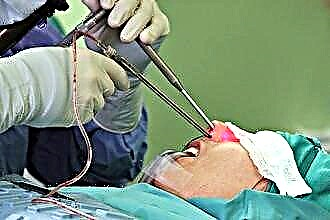Salpingootitis is an ear disease that is diagnosed with inflammatory processes in the Eustachian tube of the middle ear. This is a rather narrow (only 2 mm wide) lumen, about 2 cm long, connecting the tympanic cavity with the nasopharynx. When an infection or other cause gets in, the mucous lining becomes inflamed, the auditory tube swells, and as a result, unpleasant sensations appear and hearing deteriorates. If the disease is diagnosed early, it responds well to treatment. In a neglected state, it becomes the cause of purulent otitis media and other complications.
Main reasons
 There are several reasons why salpingootitis occurs in adults and children. Most often, it develops as a result of pathogens entering the auditory tube. This can happen if a person is sick with acute diseases affecting the upper respiratory tract: ARVI, tonsillitis, pharyngitis, flu, etc.
There are several reasons why salpingootitis occurs in adults and children. Most often, it develops as a result of pathogens entering the auditory tube. This can happen if a person is sick with acute diseases affecting the upper respiratory tract: ARVI, tonsillitis, pharyngitis, flu, etc.
Other common causes of Eustachian tube inflammation are:
- infections that have penetrated the blood or lymph flow, most often in the presence of systemic diseases: tuberculosis, scarlet fever, measles;
- a strong decrease in immunity, which is not able to suppress the development and reproduction of pathogenic fungi and bacteria present in the microflora of even a healthy person;
- congenital or acquired curvature of the nasal septum, in which the auditory tube is completely or partially blocked;
- severe allergic reactions, accompanied by profuse nasal discharge and severe swelling;
- overgrowth of polyps or adenoids, which squeeze the walls of the Eustachian tube, disrupting its blood circulation and impairing patency;
- individual features of the anatomical structure, in which the Eustachian tube is too narrow or curved.
Salpingootitis can also develop with frequent incorrect blowing out of the nose, when it is carried out simultaneously through two nostrils.
The location of the auditory tube deep in the temporal bone does not allow in most cases to notice the disease at an early stage. Moreover, pronounced painful sensations do not appear immediately, which makes diagnosis very difficult. Therefore, if you notice unusual or unpleasant sensations in your ears, it is better to immediately seek the advice of a specialist.
Symptoms of the disease
 Acute salpingootitis develops very quickly and the symptoms are clearly expressed:
Acute salpingootitis develops very quickly and the symptoms are clearly expressed:
- a sharp deterioration in hearing;
- noise or ringing in your ears;
- painful sensations;
- overflow of fluid in the ear;
- ear congestion;
- autophony.
On external examination with the help of an otoscope, redness and thickening of the tympanic membrane are clearly visible. As the disease progresses, purulent discharge may appear, which accumulates, causing strong tension in the tympanic membrane and can lead to its perforation.
The chronic form of salpingootitis is characterized by persistent hearing loss, which becomes more and more noticeable over time. Hearing is impaired because the elasticity of the tympanic membrane decreases as a result of constant tension. Destructive changes also occur in the tissues, causing its thickening.
Treatment methods
The acute form of the disease requires immediate and complex treatment, which includes:
- antibiotic therapy (oral or intramuscular);
- anti-inflammatory ear drops;
- vasoconstrictor drops in the ear or nose;
- at high temperatures - antipyretic.
After the exacerbation is removed and the body temperature is normalized, physiotherapeutic methods of treatment can be connected: UHF, electrophoresis with 2-3% calcium chloride solution, pneumomassage.
 If there is a large accumulation of pus, the doctor may decide to perforate the tympanic membrane and bypass it, which will allow the accumulated fluid to drain out. After removing the shunt, the puncture quickly heals without affecting hearing acuity. Failure to perform the manipulation in time can lead to the fact that pus will rupture the eardrum (and then it will be difficult to restore hearing completely) or cause inflammation of the meninges (meningitis).
If there is a large accumulation of pus, the doctor may decide to perforate the tympanic membrane and bypass it, which will allow the accumulated fluid to drain out. After removing the shunt, the puncture quickly heals without affecting hearing acuity. Failure to perform the manipulation in time can lead to the fact that pus will rupture the eardrum (and then it will be difficult to restore hearing completely) or cause inflammation of the meninges (meningitis).
If salpingootitis is not treated, the symptoms temporarily disappear, but a few days after stopping the use of anti-inflammatory drugs, they appear again. Therefore, it is very important to fulfill all the doctor's prescriptions and undergo a full course of therapy in order to prevent the transition of the disease into a chronic form.
Home treatment and prevention
It is possible to treat salpingootitis on your own at home only after all procedures have been agreed with the doctor. Usually, home treatment using folk remedies is prescribed at an early stage of the disease. At this time, ear warming is shown, which can be performed in several ways:
- blue lamp or solux lamp;
- a heated salt bag;
- mud cakes;
- paraffin therapy.
 Ultraviolet radiation in small doses is also useful. To increase immunity, multivitamins are used. Aloe extract injections give a good effect, but it can only be used as directed by a doctor. Important! In the acute stage of the disease, such treatment is categorically contraindicated.
Ultraviolet radiation in small doses is also useful. To increase immunity, multivitamins are used. Aloe extract injections give a good effect, but it can only be used as directed by a doctor. Important! In the acute stage of the disease, such treatment is categorically contraindicated.
As a preventive measure, it is necessary to do everything possible to strengthen the immune system: eat right, give up bad habits, undergo vitamin therapy twice a year. It is very important to avoid hypothermia, especially on the ears - wearing a headgear in cold, wet or windy weather is mandatory.
You can not run a runny nose - you must definitely drip your nose and take antiviral drugs. And at the slightest suspicion of salpingootitis, be sure to be examined by an otolaryngologist.



